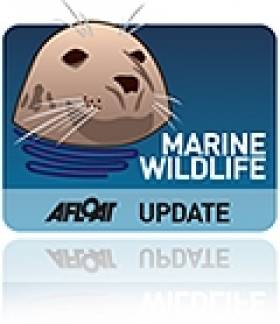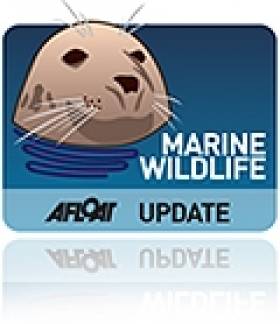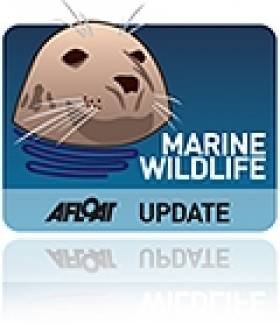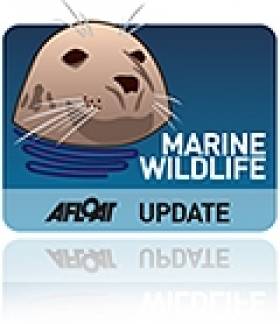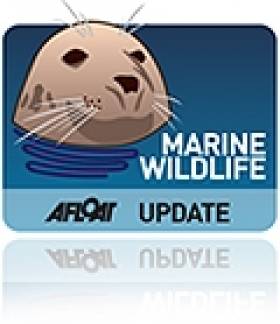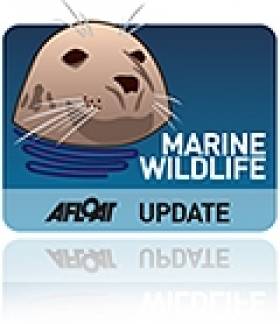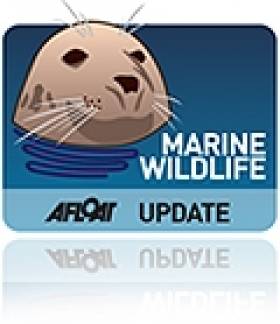Displaying items by tag: marine wildlife
Marine Mammal Sightings Needed for Irish 'Atlas' of Species
#MARINE WILDLIFE - Spotters of marine mammals such as whales and dolpins are among the country's wildlife enthusiasts being called to help compile an Atlas of Mammals in Ireland.
According to The Irish Times, more than 5,000 sightings have been logged already, but the National Biodiversity Data Centre (NBDC) needs more, and is asking members of the public, scientists and anyone with an interest in nature to send in details of whatever mammals they see.
Mammals have been chosen for the project because there is surprisingly "no or little data in terms of their distribution" despite being so commonly sighted, said NBDC director Liam Lysaght.
“We now have a system in place where we can plot the distribution of say the blue whale and the pygmy shrew."
In particular, the project aims to get better picture of the distribution of introduced species such as brown rats or mink, which can have a disastrous impact on nesting seabird colonies.
The Irish Times has much more on the story HERE.
#MARINE WILDLIFE - Ten different cetacean species were accounted for among 143 sightings validated by the Irish Whale and Dolphin Group (IWDG) for the month of June.
"It’s tempting to overinterpret sightings from a single month’s snapshot," said IWDG sightings co-ordinator Pádraig Whooley. "But we are confident that these 143 sightings... represent a reasonable sample size."
The number is less than half of the 315 records for the same month in 2009, which Whooley says "illustrates how big an influence the weather is on our ability to detect cetaceans".
Basking shark sightings are particularly down after the worst June weather on record. "There is strong evidence that the 2012 shark season is as good as over," said Whooley, noting that this year's sightings peaked as early as April.
There was a flurry of minke and humpback whale sightings off Dublin and the Kish Bank in mid-June - possibly related to the rare sighting of a minke whale breaching in the Irish Sea.
However, the vast majority of activity for these large marine mammals is off the south and southwest, with Slea Head and Dingle Bay enjoying the highest diversity.
Orcas, minke whales, humpbacks and a "blubber biomass" of six fin whales were all spotted off the Kerry coast in June, not to mention the month's largest concentration of dolphins - some 400 common dolphins spotted off Clogher Head on 10 June.
The Irish Whale and Dolphin Group has much more on the June findings HERE.
#MARINE WILDLIFE - Blackpool could have its own 'Great Barrier Reef' if proposals to set up Marine Conservations Zones in the Irish Sea get the green light, as the Blackpool Gazette reports.
Earlier this month the Lancashire Wildlife Trust launched a campaign to recruit ‘Friends of Marine Conservation Zones’, hoping to inspire locals to support marine wildlife habitats along England and Wales' Irish Sea coastlines, and push the British government to make a firm commitment on all 127 proposed marine conservation zones.
As previously reported on Afloat.ie, Westminster has postponed making a decision on the network of planned marine sanctuaries till at least next year, and some conservation groups are concerned that fewer than a quarter of the proposed zones will be enacted by law.
"Time is running out for us to save our fragile seas," said Sir David Attenborough, vice president of The Wildlife Trusts, who urged the British government "to designate the full list of 127 sites now, for day by day the wildlife in these sites is being destroyed and damaged."
The Blackpool Gazette has more on the story HERE.
Midsummer Night Cruise on Shannon Estuary Next Weekend
#MARINE WILDLIFE - Dolphinwatch Carrigaholt, in collaboration with the Irish Whale and Dolphin Group (IWDG), is offering a special midsummer night cruise in the Shannon Estuary as a fundraiser for the IWDG.
The cruise will depart Castle Pier in Carrigaholt, Co Clare at 5pm on Saturday 30 June (weather permitting), returning around 10pm,
During the trip you will visit caves off North Kerry, sea stacks and headlands and the mighty Loop Head, including the giant sea stack known as Dermot and Grainne’s Rock (or Cuchalain’s Leap) and Black Rock with its fantastic seabird colonies.
Along the way you will also expect to see marine wildlife such as bottlenose dolphins, basking sharks - and possibly even a minke whale, if a recent coastal sighting is anything to go by.
Included in the cost is a vegetarian or seafood platter and wine onboard sponsored by The Long Dock in Carrigaholt, as well as live traditional music and a €10 voucher for fine art prints and books from Carsten Krieger Photography.
Tickets for the cruise are priced at €50 for IWDG members, €60 for non-members not wishing to take out membership and €70 for non-members including a one-year IWDG membership (normally €30).
Numbers on this adults-only cruise are limited to just 35 - so book early to avoid disappointment. To book your place call 087 9175984 or e-mail [email protected].
#MARINE WILDLIFE - Experts at the Irish Whale and Dolphin Group (IWDG) have been puzzled by a rare photo of a minke whale breaching in the Irish Sea, as the Larne Times reports.
Minke whales are a regular visitor to these shores, but are not known to breach in Irish waters.
But RIB skipper Peter Christian has convinced at least one knowledgeable colleague that the eight-metre whale he snapped breaching some eight or nine times while en route from the Isle of Man to Islandmagee is the real McCoy.
Peter Steele of boat owner North Irish Diver Ltd pointed to a distinctive white patch on its pectoral fin as proof.
“It is rare for minke whales to be caught breaching in these waters, as they are normally much more sedate,” he said.
The Larne Times has more on the story HERE.
#MARINE WILDLIFE - The recent horrific reports of seal killings are but part of a "swing in activity" over the past few months, as TheJournal.ie reports.
Gardaí continue to investigate the shocking incident in Dingle two weeks ago, where the heads of two baby seals were found nailed to signs outside a wildlife sanctuary - an act condemned by fishermen in spite of their support for a cull of seals along the West coast.
Just days later, a husband and wife kayaking at Knockadoon head in East Cork were "sickened to the core" by the sight of two seals who had been shot.
And last week the Dingle Seal and Wildlife Sanctuary received calls of two separate seal deaths around the coast, one reporting a headless seal discovered at Whiting Bay in Waterford.
The incidents follow fears from earier this year of an illegal cull of marine wildlife after a two seals were found dying from bullet wounds on Tramore Beach in Co Waterford.
“There has been a swing in activity in recent months,” said Johnny Woodlock of the Dingle Seal Sanctuary, who added that many of the seals found dead "have apparent gun shot wounds" though it is difficult to determine the cause of death without an autopsy.
The National Parks and Wildlife Service (NPWS) says it has not recorded any increase in illegal seal killings off Cork or Kerry. But Woodlock claims this is because "there is nobody keeping records of dead seals washing up on beaches".
An NPWS survey of coastal seal numbers is ongoing, and exact figures have yet to be published.
TheJournal.ie has much more on the story HERE.
Unusual Marine Wildlife Finds Off West Coast
#MARINE WILDLIFE - There were some strange goings-on off Connemara last week as fishermen caught two very surprising marine wildlife finds, The Irish Times reports.
On the Aran Islands prawn grounds, skipper Colin Reynolds of the Fragrant Cloud caught an albino monkfish - the second to be landed in Rossaveal in recent years.
According to marine biologist Siubhán Ní Churraidhín, the near 2kg fish was larger than expected as the light pigmentation makes such creatures much more vulnerable to predators.
Meanwhile, the box crab was discovered by fisherman Michael O'Toole while crab and lobster potting off Inishboffin and taken to the Galway Atlantaquaria, though the delicate specimen did not last the night.
Such crabs are normally only found some 200m below the surface.
Seal Cull Needed on West Coast Says FG Councillor
#MARINE WILDLIFE - RTÉ News reports that a Fine Gael councillor for Co Galway has called for a seal cull along the West coast.
Cllr Seosamh Ó Laoi told RTÉ Raidió na Gaeltachta that the increase in the seal population was to blame for the decline in inshore fish catches.
He also made reference to times years ago when fisherman had taken matters into their own hands and "kept the place clean" by carrying guns on their boats.
His remarks come barely a week after the heads of two baby seals were found nailed to signs outside a wildlife sanctuary in Dingle. Co Kerry.
As reported on Afloat.ie, local fishermen and industry representatives later spoke out to condemn the grisly incident.
Michael Flannery of the Irish Fish Producers' Organisation (IFPO) said: "Fishermen are calling for a seal cull but we want this carried out in an organised, approved and humane way."
Fishermen Condemn Illegal Killing of Baby Seals
#MARINE WILDLIFE - Fishermen have condemned the appalling killing of two baby seals whose heads were nailed to signs outside a wildlife sanctuary in Dingle last week.
As previously reported on Afloat.ie, staff at the Dingle Wildlife and Seal Sanctuary were subject to the "sickening" sight on Thursday morning, which was alleged to be connected to a campaign among local fishermen urging for a cull of seal numbers in the area.
However, as the Irish Independent reports, fishermen have spoken out to decry the grisly incident.
Michael Hennessy, skipper of the fishing vessel Realt na Mara, said: "This kind of thing is not going to do any good for any campaign, and fishermen would not lower themselves to do something like that."
Michael Flannery of the Irish Fish Producers' Organisation (IFPO) added: "Fishermen are calling for a seal cull but we want this carried out in an organised, approved and humane way."
According to the Irish Examiner, Sea Shepherd Ireland has added a €2,000 reward to the €5,000 offered by fellow animal rights group ARAN for anyone with information leading to the arrest or conviction of those responsible for the illegal seal killing.
Meanwhile, two grey seals pups currently being cared for at the Dingle sanctuary may be released earlier than expected due to fears for their security.
Haughey Yacht Nearly Ready for New Life as Research Vessel
#TALL SHIPS - Celtic Mist - the yacht once owned by the late former Taoiseach Charles Haughey - will soon take to the waves in its new guise as a research vessel as its refit nears completion, today's Sunday Independent reports.
As reported last year on Afloat.ie, the 52-foot yacht was gifted by the Haughey family to the Irish Whale and Dolphin Group (IWDG) to assist in its marine wildlife conservation work.
After completing a leg of the Tall Ships Races from Waterford to Greenock in Scotland, the boat sailed to its new birth at Kilrush in Co Clare last July while the group raised the necessary funds to enter dry dock for refurbishments and refitting as a marine research vessel.
By January of this year the IWDG had reached 75% of the more than €60,000 required to complete the work, which involved stripping out the main cabin to increase space for equipment and crew berths.
"We are finishing off the renovations at the moment and we're hoping to have it back on the water in the next few weeks," said the IWDG's Simon Berrow. "We estimate it will cost around €80,000 by the time it is finished."
The refurbished yacht includes a fitting tribute to its previous owner in the form of a clock over his former cabin with a photo of Haughey in his skipper's cap on the background.
Berrow also hailed Haughey's love of the sea, which prompted his declaration of Irish waters as a whale and dolphin sanctuary.
The IWDG will use the Celtic Mist to train and teach its members how to survey and record whales and dolphins. As well as research projects, it will be used for educating schoolchildren about marine conservation and the abundant life in Ireland's coastal waters.
It is also hoped that President Michael D Higgins - who became patron of the IWDG in February - will be on hand to officially launch the vessel this August.
The Sunday Independent has more on the story HERE.


























